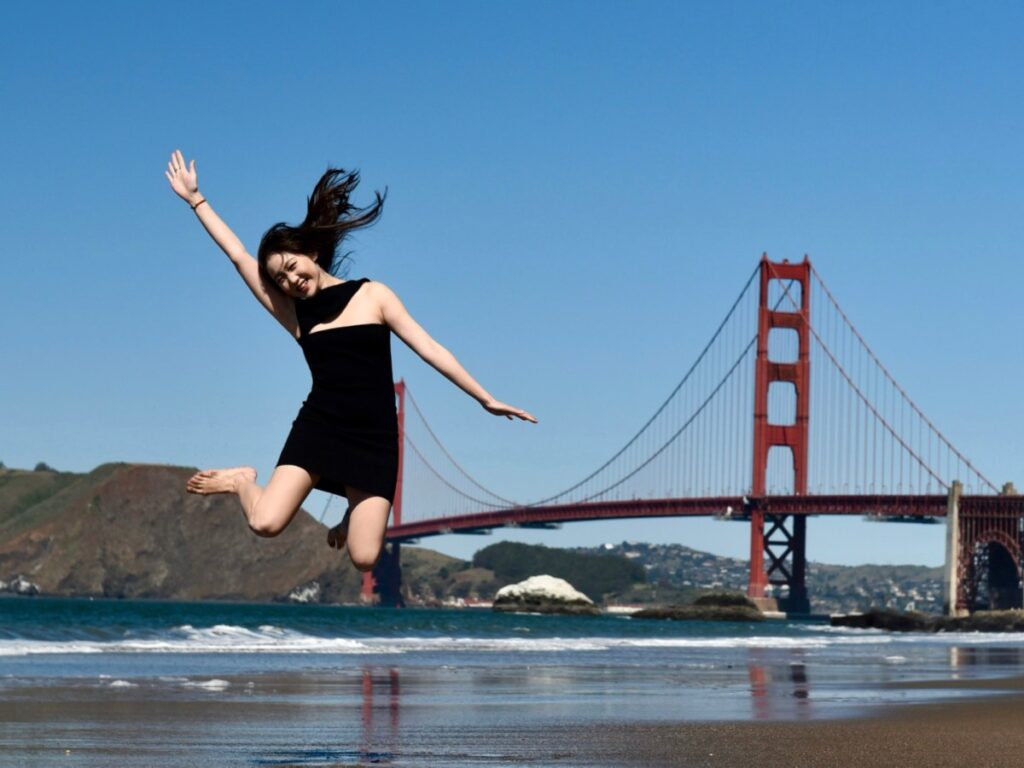By: Jaxon Lee
When listeners first encounter the cover of Building Bridges, they might pause before pressing play. The image itself captures attention. A single glowing line sketches its way across the dark, connecting Taipei 101, Jade Mountain, the Palace Museum, the White House, the Empire State Building, and the Golden Gate Bridge. It resembles a constellation made of architecture—precise yet warm. The amber light rising from the center feels like both sunrise and spotlight, a quiet hint that this is an album about becoming.
The cover was designed by pianist I-Lin Tsai herself, which feels naturally fitting. Her artistry has always existed where design meets emotion. Building Bridges evokes the feeling of a blueprint drawn in sound, an emotional architecture connecting Taiwan and America.
At first listen, the album begins with a calm and reflective tone, gradually unfolding into something rich in visual imagery.” This is more than an album to listen to; it gradually evolves and grows.
Palace Museum: Scrolls of Time begins in B-flat major with a powerful rolling chord that feels like light through ancient glass. Fast arpeggios shimmer across the keys, not for precision but for color, each sound melting into the next to create a bright, shining atmosphere. The repeated broken intervals pulse like a ticking clock, while the expressive melody tells stories of the past and how they connect to today. Behind each phrase lies the emotion, the blood, and the tears of those who shaped this history.
Chihkan Towers: Red Brick Reverie centers on C-sharp minor and carries a historic tone. The piece recounts the story of the Dutch-built tower—its destruction, its reconstruction, and its survival. Whole-tone gestures suggest the first meeting between the Dutch and the island’s original people, blending tension and discovery. Each phrase feels grounded, steady, and human, like footsteps on ancient brick.
Lungshan Temple: Incense and Rain opens in G minor with bell-like bass notes that later echo in the higher register. The repeated tones sound like raindrops, as if thousands of whispered prayers are rising through the air. The piece breathes quietly, holding warmth, faith, and the sound of devotion.
Taroko Gorge: Marble Cathedral blurs its tonal center, drawing on Ravel’s harmonic colors and Debussy’s textures. The music feels like wind flowing through the gorge, tracing the changing reflections of rocks and water. Pentatonic gestures recall the beauty of Eastern sound. Minimal breaks between phrases create a sense of breathless movement—shifting, vivid, alive.
Taichung Night Market breaks into a lively ragtime rhythm. It feels carefree, bright, and slightly chaotic, like walking through the market after a long day—holding skewers and ice cream, laughing under neon light. The playing style is loose and direct, capturing the spirit of the crowd rather than its order.
Sun Moon Lake: Mirror of Two Heavens moves gently. The dialogue between voices feels like reflections on water. Each melodic thread connects like ripples across the surface—a single, steady heartbeat shared by generations of Taiwanese hearts.
Jade Mountain: Ascent to Jade bursts with life. The opening evokes the sound of birdsong. Fast passages sparkle like wind over stone. The continuous trills feel wild and natural, echoing the high mountain’s call. The piece captures the pulse of nature at its free.
Taipei 101: Skyward Aspirations begins in G major with bright, uplifting motion. The rhythm beats like a city’s heart. The harmonies feel like glass catching sunlight—clean, modern, alive. It’s not just a portrait of a building but a symbol of hope and ambition: growing higher, growing stronger, shining at the top of the world.
The White House: We the People in E-flat major feels warm and grounded. It does not speak of power but of home. The melody breathes with quiet strength and care. Tsai calls it “a home that unites people’s hearts and voices,” and that sense of humanity flows through every phrase. The piece carries calm dignity, reminding the listener that true strength often begins with compassion.
Empire State Building: Art Deco Anthem sparkles with jazzy, urban brilliance. The notes are sharp and bright, a nod to the skyscraper’s steel geometry. The energy recalls Gershwin’s New York but with the crisp wit of Paul Schoenfield—urban rhythm reimagined through a classical voice.
Hollywood: Dream Factory enters like a waltz covered in rose petals and champagne bubbles. It feels innocent, elegant, and cinematic. Yet behind its shimmer is quiet irony—the effort, the work, the tears behind every moment of glamour. It is a dream that shines even as it fades.
Grand Canyon: Time’s Cathedral begins in D minor, shifts through D-flat major, and resolves in a dramatic B-flat minor. The tonal journey feels vast and physical. Air fills the space between chords, and each one lands slow and heavy, like footsteps through time. The piece has resonated with listeners, reaching nearly 30,000 plays online within its first week of release.
Pike Place Market: Neon and Rain returns to color and motion. The rhythm feels bright, quick, and human. Every day sounds—voices, footsteps, the splash of rain—turn into melody.
Lake Tahoe: Sapphire Divide and Denali: The High One quieted the mood again. Their sound is clear and open, like a breath of mountain air. Each note feels intentional. Each rest is necessary.
Finally, Golden Gate Bridge: Across the Fog closes the album with a jazzy, playful tone. The harmonies glow orange like the bridge itself, warm but veiled in mist. The rhythm fades gently into silence. The music does not end—it dissolves, like fog lifting from the bay.
Building Bridges is available now on Apple Music and Spotify.
Visit www.ilintsai.com to explore the journey.











